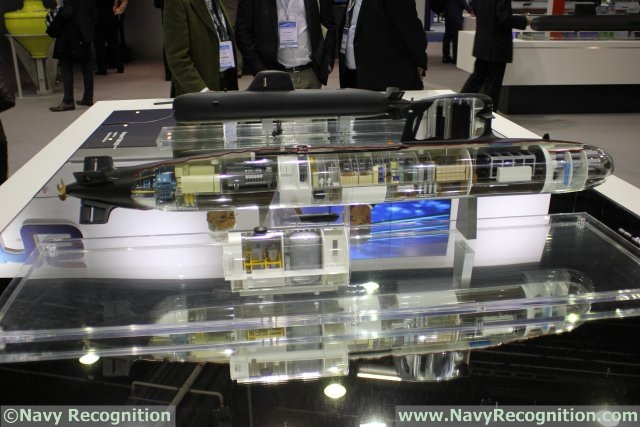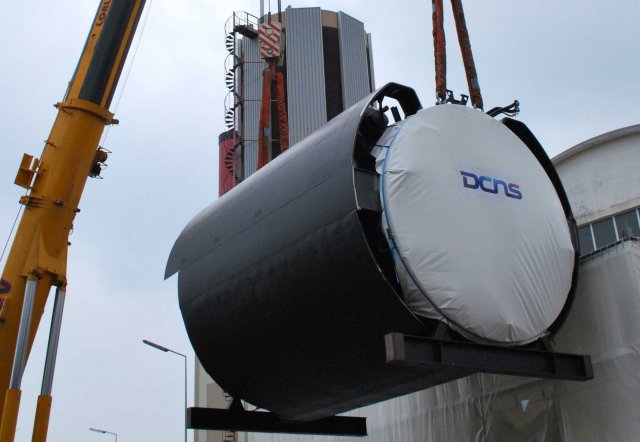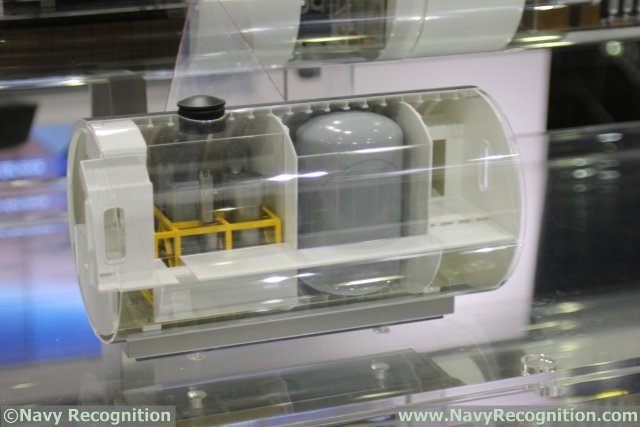| |
||||||||||||||||||
| a | ||||||||||||||||||
EURONAVAL
2014 Show Daily - DCNS |
||||||||||||||||||
Major
DCNS innovations, presented at EURONAVAL, 2014 improve submarine capabilities |
||||||||||||||||||
At
Euronaval 2014, DCNS is unveiling major innovations in three key areas
– improved submerged endurance, enhanced surface intelligence
gathering, and deployment of unmanned underwater vehicles – to
improve the performance and safety of conventional-propulsion submarines.
All these new developments illustrate the unique expertise and innovative
potential of DCNS teams. |
||||||||||||||||||
 Scorpene-type submarine with a fuel-cell 2nd generation showcases by
DCNS at EURONAVAL 2014
Scorpene-type submarine with a fuel-cell 2nd generation showcases by
DCNS at EURONAVAL 2014 |
||||||||||||||||||
To
meet demand from customers for improved submerged endurance of conventional-propulsion
submarines (SSKs), DCNS now offers dedicated hull sections known as
Autonomy Boosting Sections. Whereas SSKs typically have a submerged endurance of about three days, DCNS now proposes three new technologies to extend this critical parameter to three weeks, sharing the same key principles: - Modularity and independence: integrated in completely autonomous sections, they can be added during submarine's life time. - Up-to-date and dual technologies: for maximum safety, evolutivity and value for money, they exploit proven civilian technology and benefit from the associated R&D and feedback. - Easy logistics around the world: using standard fuels, these solutions allow submarines being refuelled far from home-base without deploying heavy specific logistics means. The first is a hull plug equipped with new-generation high-capacity lithium-ion batteries. Easy to operate, the technology offers high submerged speeds on demand and improved response to power ramp-up and variations. Lithium-ion batteries can also be recharged at sea. The endurance of a Scorpene-type submarine is increased to seven days at 4 kts (or 1 day at 12 kts) resulting in a significantly enhanced tactical capability. The advantages of the Li-Ion section are: - a maximum powers compatible with high-speed, without discharging the ship lead-acid batteries, - a cell technology and monitoring systems ensure respect of submarine safety requirements, - to be rechargeable at sea, - an easy and flexible use. The lithium-ion section encompasses: - lithium-ion modules, - a control system, fully integrated within the platform management system, operated from the control room, - its own ancillaries: cooling systems, safety devices... When required by operational use, the lithium-ion batteries supply the propulsion motor. This configuration can be taken very rapidly, and even for short periods. The submarine fitted with this section keeps its initial lead-acid batteries, and require no modification of his global electric network architecture and components. The lithium-ion batteries can be recharged at sea with the submarine's diesel engines.  Mesma air-independent
propulsion (AIP) system can be installed on Scorpene submarines
Mesma air-independent
propulsion (AIP) system can be installed on Scorpene submarines
Mesma encompasses: - a compact oxygen module, - an energy module, composed of a combustion chamber, a turbine, and a closed water circuit, - a control and monitoring system, fully integrated within the platform management system, operated from the control room, - its own ancillaries: trimming tanks, cooling systems, safety devices. It has no impact on the ship equilibrium and crew comfort. The hot source of the steam cycle is the combustion chamber. It produces the steam that is sent in the turbine to produce electricity. Cold source is provided by seawater circulation. Using the technologies developed for Le Triomphant - class SSBN, Mesma preserves the global acoustic signature.  Fuel-cell 2nd generation section for Scorpene-type submarines first revealed at EURONAVAL 2014 - the hydrogen produced on demand avoid storage contraints and hazards, - the absence of pure-oxygen in the cells allows longer life cycle, - the fuel is easily available worldwide. The fuel-cell 2nd generation encompasses: - a compact oxygen module, - an energy module, composed of a fuel processor and the cells to produce electricity, - a control system, fully integrated within the platform management system, operated from the control room, - its own ancillaries: trimming tank, cooling systems, safety devices. There is no impact on the ship equilibrium and the crew comfort. The fuel processor generates pure hydrogen. Pure oxygen is mixed with nitrogen to create the air used by the dual-technologies fuel-cells. These fuel-cells combine oxygen and hydrogen, to produce water and electricity. The fuel-cell 2nd generation increases submerged endurance to three weeks (at 4kts); a capability that confers a decisive advantage in certain theatres of operations. This is a technological breakthrough compared to existing solutions (even in Europe) because the system generates less oxidation and increases the lifetime of the propulsion system. In addition, the maintenance cycle of the fuel-cell now matches the maintenance cycle of the whole submarine while existing solutions are very maintenance intesive.  DCNS
Vipère multifunction buoy presented at EURONAVAL 2014 DCNS
Vipère multifunction buoy presented at EURONAVAL 2014
A pioneer in the field, DCNS achieved a world first in July 2014 when it tested a unmanned underwater vehicle (UUV) launch and recovery system using a platform specially designed to simulate the forces acting on a moving submarine. The test campaign with an Ifremer-designed Aster X UUV was the culmination of an R&D project lasting close to two years. The UUV solution offers the key advantage of never compromising the submarine's discretion. It uses acoustic signals for long-range guidance then switches automatically to an optical system when the host comes within visual range. The UUV then docks with a docking structure on the submarine. | ||||||||||||||||||
Major DCNS innovations, presented at EURONAVAL 2014, improve submarine capabilities
- Posted On










